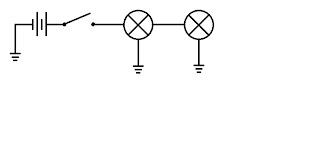
With each bulb having their own positive supply they recieve the full available voltage from the power supply. This means that they will glow at their full brightness.
When measuring the available voltage at each bulb, they both did recieve the full power supply voltage.
The amperage flowing through bulb 1 and 2 was 0.73 A. The total amperage flowing in the circuit was 1.46.
This means that amperage is shared in the circuit, but it is higher due to both of the bulbs amerage's being added together (and the amperage at each one being what is sufficiant to light the bulb) to get the total circuit amperage.
Calculating total resistance in a parallel circuit, you put 1 over each of the values. Eg 1/16.42
These are added together. Eg 1/16.42 + 1/16.41
Then you put 1 over the answer. Eg 1/0.122
You will then get your answer. = 8.20
Adding a third light bulb in parallel increases the total amperage in the circuit but all bulbs still recieve the total available voltage from the power supply. So for every consumer added in parallel the total amperage will increase.
No comments:
Post a Comment